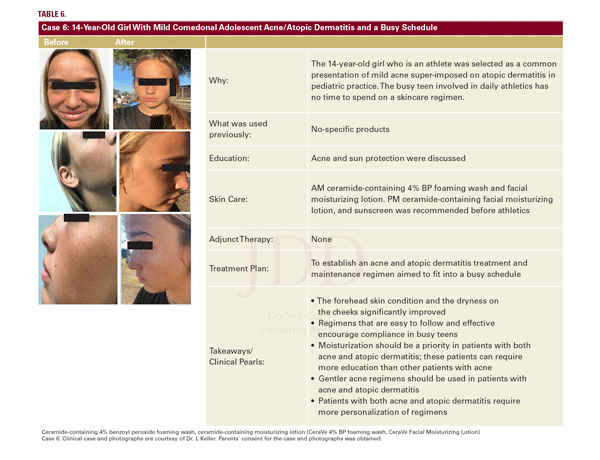
Although evidence is scarce, researchers are increasingly interested in follicular epithelial barrier dysfunction in patients with acne.6,15-17,28-31 A consensus paper stated that dryness and skin irritation resulting from acne treatment could be improved using ceramide-containing cleansers and moisturizers, enhancing treatment adherence.16 The authors stated that the skincare regimen should be an essential part of the acne prevention, treatment, and maintenance care regimen.16 Skin care is necessary for acne treatment and is part of various acne guidelines and consensus papers.6,15-17,28-31
Newer, nonsteroidal, or low-potency steroid topicals can address intermittent AD flares in these patients; parents should be instructed not to use leftover mid- or high-potency topical or oral steroids.29,30
CASE 7
A 15-year-old girl with SOC and moderate adolescent acne and PIH (Table 7). This case highlights the issues patients with SOC and acne may face. Many pediatric and adult patients with richly pigmented skin and acne are more concerned with PIH than with acne; these patients should be instructed that the key to preventing PIH is to prevent and effectively treat acne.9,14,27,36,37
Acne prevalence and sequelae are considered more common in SOC populations.9,32-37 PIH may be due to inflammation-inducing excessive melanin production or irregular pigment dispersion, although the mechanism is yet to be elucidated.33,34 Early and effective acne treatment with topical adapalene combined with BPO can prevent the risk of future PIH and acne-related scars.14,30-37
Acne prevalence and sequelae are considered more common in SOC populations.9,32-37 PIH may be due to inflammation-inducing excessive melanin production or irregular pigment dispersion, although the mechanism is yet to be elucidated.33,34 Early and effective acne treatment with topical adapalene combined with BPO can prevent the risk of future PIH and acne-related scars.14,30-37






